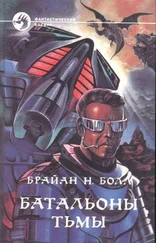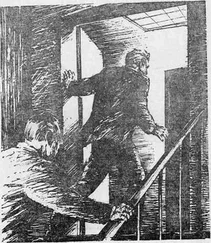“The Army could do it,” Collins agreed, “but none of that gear is here. Getting them to bring it back again for an unofficial project would be hell. Even if it was here, asking them to go out that far would be tough. They might, but none of that equipment is anywhere closer than Sondrestrom at the best.”
Perry Feinberg appeared and was introduced to Collins. He sat down and, in a drastic departure from his usual form, displayed a hint of discouragement. “The troops are dis-spirited,” he reported. “The stuff is all unloaded and in the hangar, but it was a chore.”
“How do we stand?”
“We’ve got both outer wing panels, all four props, three engines, and the complete tail assembly. And some miscellaneous bits and pieces. But those damn wing roots. .”
“We’ve discarded the idea of dog teams,” Holcomb told him. “And the Army has taken away the stuff it used to build Camp Century.”
Perry Feinberg began to recover. “I covered the same ground and got the same answers. However, we do have Trackmasters here for use in phases. If we built a sled that would hold them, we might be able to airlift the sled out there and also a Trackmaster. Of course the colonel would have to approve that and he is a bear about keeping all rescue equipment on the ready at all times. The Trackmasters are rescue vehicles.”
Ferguson was looking hard at the table top, hearing nothing. The others noted his condition and waited. Finally, he looked at Collins. “What kind of choppers do you fly?” he asked.
“Jollies. Jolly Green Giants. HH-3’s.”
“What kind of an operating range do you have?”
“Maximum, about a hundred and seventy miles.”
That figure was a blow, but Ferguson persisted. “How many do you have?”
“Two. That was the full complement of aircraft here at Thule until you arrived with that fixed-wing monster.”
Ferguson ignored the jibe; greater matters were on his mind. “How much weight can a helicopter lift?” he asked.
“The sky crane can hoist ten tons with no sweat.”
“How much can a Jolly lift?”
“That depends on the fuel load and what equipment is on board. Normally we carry six thousand pounds of fuel. And because we are rescue vehicles, we have to have eight hundred pounds of rescue gear on board at all times.”
“But with full tanks and all the rescue gear, you still have a reserve capacity?”
“Oh, sure, we carry a full load of passengers, their baggage, and the crew.”
“With a half-fuel load, then, you could pick up a piece of hardware that weighed twelve to fifteen hundred pounds.”
“With a sling, no sweat. I know what you’re thinking, but we don’t have anything like the range to go and get those wing roots for you.”
Perry Feinberg had a thought. “Just suppose,” he said, “that we were out on the ice cap and stranded where the B-17 is. For some reason, we couldn’t fly. What then?”
Collins shrugged his shoulders. “Then we’d come and get you, that’s all.”
“How?” Holcomb asked.
“Several ways. When an active rescue is on, and lives are at stake, we do a lot of things that aren’t in the book. We have a midair refueling capability, but that calls for a tanker, of course.”
“What kind of a tanker?”
“A C-130.”
“Ah!”
“But it has to be specially equipped and yours won’t do.”
Ferguson was thinking intensely. “Maybe it will,” he declared. “Not for midair refueling, but we sure as hell can spot fuel bladders or drums for you along the route.”
“And put beepers on them so you can find them,” Holcomb added.
“You’d have to talk to the major,” Collins said.
“I am acquainted with the major,” Feinberg said. “A splendid gentleman and of course a superb pilot, but something of a stickler for the rules.”
“That he is.”
“One last question,” Ferguson interjected. “Tom, suppose somehow we could get this set up — do you see any technical reason why it wouldn’t be possible?”
Collins thought. “No, none that we couldn’t overcome. You know the reputation of the Jollies. It would be a helluva operation, but we could probably hack it.”
Andy was not satisfied. “And if we did manage to get approval, would the guys at Det. Four go for it? Would they give us a hand?”
“Oh hell yes,” Collins answered.
* * *
To Sergeant William Stovers, a problem was not something to worry about — it was something to be solved. It was in that context that while the others were talking in the NCO Club, he pushed open the series of doors that gave access to the hangar where Det. 4 was housed, stamped the snow off his feet, and hung up his parka. Then he went inside. With a sure instinct he avoided the section where the commander and the other officers would be found and instead located the area where the working NCO’s were busy.
He was made welcome. A mug of hot coffee was placed in his hand and a chair was put at his disposal.
“I’ve got to admit,” he said, “that I know very little about helicopters. Since I’m going to be up here awhile, it seemed like a good idea to come down and find out a few things.”
“That’s a helluva good idea,” the chief of maintenance responded. “Have you had any rotary-wing experience at all?”
“A couple of superficial rides,” Stovers answered, “but all I did was sit on my butt in the cabin.”
“Let’s go look at the airplanes,” the chief suggested.
Stovers was so well attuned to what he was doing, he did not even flinch when he heard the word “airplanes.” He followed his guide into the main hangar area, where two of the big helicopters were sitting in perfect alignment side by side. There was plenty of space between them, Stovers noted, and the housekeeping inside the hangar was immaculate.
“We always maintain an alert posture,” the Det. 4 man explained. “Of course, we never know when a call may come in, but when one does — we’re ready. If we have any reason to expect one, we have one of the airplanes fully cocked so that all the crew has to do is to jump on board and hit the starters.”
“How do you cock them?” Stovers asked.
“We go through all the preliminary checklists — and they’re quite complicated — and take everything up to the ‘start engines’ stage. After that no one touches the ship or changes anything. If any work becomes necessary, we go through the whole thing again.”
“They must be very complex machines.”
“That’s right, Bill, they are. They have all kinds of special systems and flying them isn’t that easy.”
Stovers began to lead into his subject. He looked carefully inside the cabin and counted the available seats. He measured the remaining cargo space with an experienced eye. Then he studied the size of the airframe and tried to relate the physical dimensions to the machine’s ability to lift. “I see that you can carry ten or twelve pax,” he commented.
“Yes, easily. Plus all their gear and baggage. We do that all the time when we go out to the Eskimo villages.”
“You carry a lot of semi-permanent gear.”
“Yes, that’s all rescue equipment. It has to be on board at all times. If we get a call when we’re going someplace, we can divert right then and there and we’ll have everything with us. About eight hundred pounds worth.”
“Isn’t it true,” Stovers asked, “that you can also carry things externally?”
“Absolutely, that’s one of the advantages of a helicopter. They use them, for instance, in erecting high tension towers. When they want to build a cross-country electrical trunk line, they assemble the tops of the towers on the ground, which is a lot easier. Then a helicopter picks them up, one after another, and puts them in place. A skyhook in other words.”
Читать дальше












